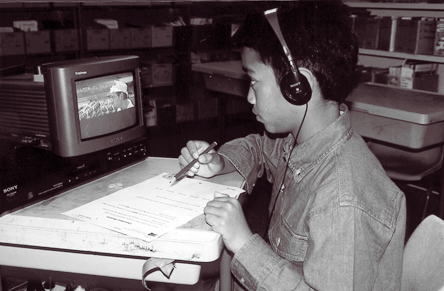New Zealand's
National Education Monitoring Project
commenced in 1993, with the task of assessing and reporting on the achievement
of New Zealand primary school children in all areas of the school curriculum.
Children are assessed at two class levels: Year 4 (halfway through primary
education) and Year 8 (at the end of primary education). Different curriculum
areas and skills are assessed each year, over a four year cycle. The main
goal of national monitoring is to provide detailed information about what
children can do so that patterns of performance can be recognised, successes
celebrated, and desirable changes to educational practices and resources identified
and implemented.
Each year, small random samples of children are selected nationally, then assessed in their own schools by teachers specially seconded and trained for this work. Task instructions are given orally by teachers, through video presentations, or in writing. Many of the assessment tasks involve the children in the use of equipment and supplies. Their responses are presented orally, by demonstration, in writing, or through submission of other physical products. Many of the responses are recorded on videotape for subsequent analysis.
 In
1998, the fourth year that national monitoring was implemented, two areas
were assessed: health and physical education, and the writing, listening and
viewing components of the English curriculum. This report presents details
and results of the assessments of students' skills and knowledge in listening
and viewing.
In
1998, the fourth year that national monitoring was implemented, two areas
were assessed: health and physical education, and the writing, listening and
viewing components of the English curriculum. This report presents details
and results of the assessments of students' skills and knowledge in listening
and viewing.
The frameworks for listening and viewing are presented in the Assessing Listening and Viewing section. The listening framework has as its central organising theme constructing meaning from spoken messages and communications for a range of purposes. Seven purposes are specified in the framework, together with a number of understandings, skills and attitudes that students and their teachers are working to develop. The viewing framework has as its theme constructing meaning from visual texts. In other respects it has a parallel structure to the listening framework.
Information about students' listening skills and understandings is presented in the Listening section. Year 4 students performed almost as well as year 8 students on the five tasks that were identical for both year levels. Averaged across the components of these tasks, only 13 percent more year 8 students than year 4 students were successful with the tasks. Differences were generally slight where the main task requirements were recalling and retelling information. The greatest differences between year 4 and year 8 students were found when task components required inference or suited students with greater existing knowledge.
The Viewing section of the report presents results for the viewing tasks, which assessed the students' capabilities in constructing meaning from visual material. Averaged across the tasks or task components that were identical for both years, about 20 percent more year 8 students than year 4 students performed at a level representing good or excellent success with the tasks. This difference was fairly consistent on the different tasks. At both year levels, students were more successful at extracting information from visual material than at understanding or explaining the effects intended by the designers of the material.
Chapter 5 reports the results of analyses that compared the performance of different demographic subgroups. School size, school type (full primary or intermediate school), community size or geographic zone did not seem to be important factors predicting achievement on listening and viewing tasks. At both year levels, girls performed better than boys on some tasks, with the proportion of tasks favouring girls increasing from year 4 to year 8. Non-Mäori students outperformed Mäori students on about half of the tasks at both year levels. Students attending schools with high proportions of Mäori students performed worse than students attending other schools on about two-thirds of the tasks at year 4 level, but this improved at year 8 level with differences on only about one third of tasks. An even more marked improvement was observed for students attending schools with more than five percent Pacific Island students: they performed worse than students at other schools on about half of the year 4 tasks but on less than ten percent of the year 8 tasks. The most disturbing results involved the school socio-economic index, with statistically significant differences in the performance of students from low, medium and high decile schools on 94 percent of the year 4 tasks and 82 percent of the year 8 tasks.
